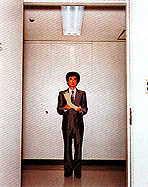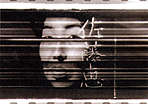
|
|
May 20, 1997 (a)
|
Column Index - Apr. 22, 1997
![]()

"TOKYO TODAY
- Tokyo from the Eyes of European Photographers"
Lars Tunbjörk, who became free-lance from being a photographer
for a Swedish newspaper
Paolo Gioli, known for experimental works using various methods
Manfred Willman, known as the founder of
"Camera Australia" magazine
Photograph: Tokyo Metropolitan Museum of Photography
TOKYO TODAY
Spanish Photography Database, Joan Fontcuberta
"THE REAL, THE FICTIONS, THE VIRTUAL"
- introdoction from Joan Fontcuberta
Palazzo delle Esposizioni/1996 - Paolo Gioli
Paolo Gioli
Lars Tunbjork - Reference Page
|
<<TOKYO TODAY>>
The background for the opening of the exhibition The <<TOKYO TODAY>> exhibition was one that was difficult to comprehend. I saw the exhibition on the opening day, brought home a catalog, and reviewed it once more, and usually that would be enough to grasp the intention and the outline of an exhibition, but for this particular event, there seemed to be some parts that remain unclear. According to the section titled, "Until the Opening of 'Tokyo Today'" inside the catalog (written by Shuji KOGI, Secretary General, EU Japan Fest Japan Committee), the opening of the exhibition was decided at the European Cultural Capital Network meeting held in October,1995, at Nicosia, Cyprus. The European Cultural Capital has been stipulated since 1965 to further the mutual understanding of the European countries' cultures, and the capital of EU nations take turn in holding such an event. In cooperation with the event, the EU Japan Fest Japan Committee was established "with the support from the Japanese government, the municipalities, and the private sector". <<TOKYO TODAY>> was held as part of the "Fest" for the purpose of cultural exchange between Europe and Japan. The artistic director who supervised the overall project was the former director of the Centre National de la Photographie of France, Robert Delpire, and "a total of 24 photographers - chosen from the 16 Cultural Capitals of Europe from 1985 to 2000, the 6 Cultural Capitals of Europe for the month from 1992 to 1997 (chosen every year from the peripheral countries of the EU), and Tokyo (2 participants) - were chosen as exhibiting artists. Although the theme of "The People Living in Tokyo, and Their Lives" for this project poses a fundamental question of why the focus is on Tokyo, this event is not so bad as a cultural exchange program. However, looking at the exhibition, the reason why such a large budget was invested for this exhibition (3 weeks' worth of accommodation expenses for the photographers in Tokyo alone are costly) remains unclear. How to treat the fragments of "Tokyo" There was no doubt that all 24 artists were competent and their works were of high standard. However, if one displayed the works by photographers like Joan Fontcuberta from Spain, Manfred Willman from Australia, and Paolo Gioli from Italy, who use the manipulation (manipulation and processing) method for expression, along with photographers who have a strong documentary touch in their works, there is bound to be disharmony. If, as Delpire admits, "none of the 24 photographers that were chosen felt any need to communicate reality objectively", no other form of exhibition besides the collection of solo exhibitions could be possible. However, in the exhibition, the works of particular artists, such as Lars Tunbjörk from Sweden, were scattered here and there, making it extremely difficult to understand. If confusion was how the director expressed the impression of Tokyo, there is no room for an argument, but simply displaying photographs of various sizes and contents, is equivalent to waiving the right as a curator. For example, this exhibition was like those where curators of art museums and critics in Tokyo hold exhibitions in Paris, London or Barcelona based on the theme of the city. If so, whose work to select, and how to exhibit them should have been decided after careful discussions with the appropriate people who had adequate information about the trend of the photographers, and about the cultural and social situation of the hosting nation. In the case of <<TOKYO TODAY>>, as we can see in how poorly the works of one of the chosen Japanese photographers, Masato SETO, were treated (hung three in a row in a small space), good communication could not have taken place. It is true that the photographs only show a part of Tokyo at the turn of the century, but scattering fragments merely as "fragments" does not help us "consider life through culture and art" (from Kogi's sentence mentioned above). The opening reception was very glamorous, with the presence of participating photographers and even an eminent politician. On the other hand, it was probably not only myself who felt a certain kind of "intransparency" in that "bubble economy-like" atmosphere. To say the least, if there were such a large budget, a long term documentary project of recording the scenes of Tokyo would have been much more fruitful. [Kohtaro IIZAWA/Photography Critic]
|
|
|
|
|
|
|
|
|
May 20, 1997 (a)
|
[home]/[Art information]/[Art Watch]
Copyright (c) Dai Nippon Printing Co., Ltd. 1997
Network Museum & Magazine Project / nmp@nt.cio.dnp.co.jp


